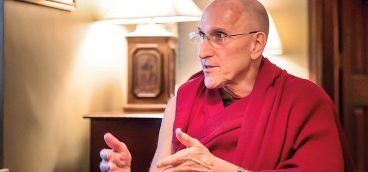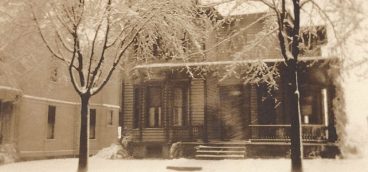Immigration Is Still Our Greatest Asset…

Each time Thanksgiving rolls around, I can’t help but recall my family’s humble arrival to these shores and the impact they had upon their adopted homeland.
My First People came to this country as scorned refugees not knowing a word of the native language. In fact, they arrogantly refused to speak anything other than their own tongue, preferring to live in secluded ethnic enclaves and resisting all attempts to be integrated into the New World culture.
Importers of deadly disease? Within a decade after landing, my people’s hygiene habits generated epidemics wiping out close to 90 percent of the host population. Prolific breeding ensured demographic edge; our own clan produced over 50 offspring in its first two American generations.
Talk about a walking crime wave: in one horrific (but not atypical) instance, my immigrant forebears perpetrated a monstrous home invasion that burnt alive an entire settlement of nearly 700 sleeping men, women and children. In addition to their rampant theft of land and economic resources, my people were religious zealots who enforced a harsh, extremist ideology within their group while demanding neighbors outside their faith be subject to a similar primitive sharia.
My immigrant ancestors were a straightup, bloody nightmare. They were New England Puritans, whose epic nation-building exploits Americans revere each Turkey Day.
They were Thomas and Elizabeth Holcomb of Devonshire, England, persecuted people of faith who landed in 1630 in Dorchester, Massachusetts, as uninvited guests of the friendly and soon-to-be-extinct Wampanoag tribe. Five years later the Holcombs joined a breakaway dissenter group that settled Windsor, Connecticut, where you’ll find their names chiseled into the Founders Monument on Palisado Green close by Discovery Daycare and the Beanery Bistro.
They were present during the infamous Pequot War of 1636–37 that expunged an entire tribal nation; they may well have been in the gawking crowd when the first North American witches (a.k.a. political radicals) were tried and executed in Windsor in 1647.
Nice folks, my Puritan peeps. Twelve generations later, I’ve likely still got some bigtime karma to work off.
With historical hindsight, it’s easy to see that the Wampanoag and other indigenous people throughout the Western Hemisphere could have saved themselves centuries of misery by repelling every European newcomer boating ashore instead of welcoming them with feasts and wilderness survival workshops. Yet my Puritan ancestors simply did what immigrants always do after coming to a new country—transform it in a myriad of ways that alter the host society forever.
In their case, planting seeds for the world’s first democratically governed society and providing mythic inspiration for generations of overeaters.
Unlike the 1600s, today’s America has an entrenched yet flexible economic, social and political structure capable of accommodating change without cataclysmic consequence to either native or newcomer. It hasn’t always been easy, but we’ve learned how to blend cultures instead of obliterate them.
The fundamental immigration problem America needs to solve in the 21st century is not how to keep people out but how to more successfully and rapidly integrate them when they arrive. Immigration affects every aspect of life in every corner of the U.S. It is imperative we make it work to our advantage.
Scores of studies cite the significant role immigrants play in boosting the current U.S. economy: immigrant-owned small businesses employ an estimated 5 million workers, generating almost $800 billion in annual revenue; in the last 20 years, immigrants have initiated 33% of public U.S. companies backed by venture capital investors; 25% of U.S. patents are obtained by immigrants; more than 40% of current Fortune 500 companies were founded by immigrants or their children, including Google, eBay, Yahoo! and Sun Microsystems.
Those who complain about the cost of putting into place an expanded, focused framework of assimilation programs should consider what it will cost if we don’t have them.
Two current strategies proven to accelerate immigrant integration are newcomer schools for youth and expanded citizenship classes for adults.
Since the 1980s many public school districts have offered voluntary special programs for grades K–12 called “newcomer schools” that provide intensive education designed to help newly arrived students transition into the mainstream education system and general American life. Courses consist of English instruction, practical skills training and U.S. cultural literacy. Though newcomer schools are sometimes organized as charter schools, they are not intended to supplant public school education but, rather, to enhance it.
For adults, thousands of citizenship classes are found across the country in a myriad of venues ranging from public libraries and schools to churches, community centers and private non-profit groups. Their curricula concentrate on preparing immigrants for the U.S. Citizenship Test.
Why not streamline the assimilation process by combining these two endeavors?
A coordinated nationwide network of “New Citizen Schools” would provide immigrants of any age with the basic information they need to become more productive Americans more quickly.
New Citizen Schools could be housed within the existing educational structure of the nearly 1,200 community colleges that already offer quality English as Second Language classes and job training programs as well as an ethnically diverse student body. The NCS program would be open to youth and adults, with students organized by age level and English-language facility. Funding would come from a base of federal, state and county education budget allotments supplemented by contributions from private foundations and American businesses and their affiliated trade associations that profit from a large employment of immigrant labor, be it blue- or white-collar, high-tech or agriculture.
New Citizens Schools would also work closely with a revamped Guest Worker Program offering immigrants what the GWP does not offer now: genuine access to education and economic mobility and legal oversight to prevent abuses by employers or criminals.
New Citizen Schools would lay the groundwork for true national security that walls and punitive deportations never will: transforming immigrants into citizens who embrace the core values of the American social ideal as they strive to attain the American economic dream.
The chief capital assets of a 21st-century economy are its people. Pittsburgh must have workers who are educated, skilled, healthy and—most importantly—emotionally committed to serving the national interest … workers motivated to add net value to the social and political system they share with millions of others.
The foundation for 19th- and 20th-century American economic growth was forged by a massive, decades-long investment of combined private-public funding for education, industry, transportation and science—powered by the human capital of immigrant workers from every corner of the globe.
A similar scale of concentrated investment should be applied now toward integrating the immigrant worker who embodies the nation’s most adaptable and promising economic resource.
Top-performing economies of Tomorrow will depend not just on raw labor but on the inspired, inventive business visioning of workers and entrepreneurs seeking better ways to accomplish more in a constantly evolving global marketplace.
The power to dream and the will to persevere against enormous odds are exactly the kickstart Pittsburgh needs at this point in time. Immigrants possess these qualities in abundance, from Andrew Carnegie, Alexander Graham Bell, Elizabeth Blackwell, Albert Einstein, Levi Strauss and Liz Claiborne to the newcomers of today.
Yes, they’ll change our society in subtle and occasionally not-so-subtle ways, but the society that does not adapt to change will inevitably decline and perish.
But don’t take my word for it. Ask a member of the Wampanoag nation.
Next time you meet one.




